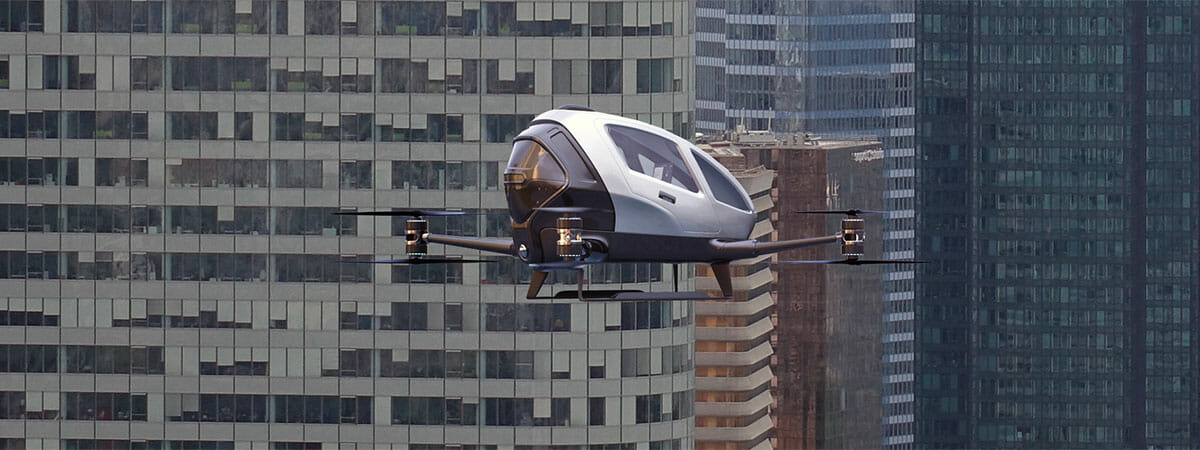The transportation of people and goods has been essential for human development. This has meant the creation of important land, sea and air communication routes, which have allowed and encouraged globalization, a significant decrease in costs and reduction in transportation times.
Likewise, mobility within cities has evolved hand in hand with population growth, and currently represents a significant challenge, not only because of the feat that moving between two points in a large city can entail due to distances and travel time, but also in terms of emissions to the environment and the detriment to the quality of life of the inhabitants of the cities.
Advanced Air Mobility will become a reality within 3 to 5 years. Although many initiatives are being developed around the world, it will be the joint involvement of all players that will lead to the development of the first success stories.
That is why many of the efforts made by the different organizations have focused on improving and prioritizing means of transportation, with the aim of discouraging the movement of people in private motor vehicles and encouraging the use of public transportation and zero emission vehicles.
This conception is shared by the European Commission and the UN in the 2030 agenda on Sustainable Development objectives, along with its simultaneous promotion by different governments and public bodies.
Along these lines, the Institute for Energy Diversification and Saving (IDEA) has developed the “urban mobility pyramid” to help raise awareness among the population about the importance of prioritizing the different types of transportation in cities when creating sustainability policies. It highlights that mobility in cities should be encouraged as follows:
- Pedestrians
- Cyclists
- Public transportation
- Urban distribution of goods
- Shared vehicles
- Private vehicles
Currently, half of the global population lives in cities (3.5 billion people), and it is estimated that by the year 2030 this figure will increase to 5 billion people. If, in addition, we consider that cities represent 75% of carbon emissions (different studies estimate that more than 70% of these emissions are generated by land transport), they bring an important foundation for improvement for the sustainability of the planet.
The need thus arises to create HUBs (operations centers) that integrate the different public transport systems: subway, railway, buses and airports.
Vertiports are an example of these types of hubs, whose aim is to connect and integrate present and future urban transport systems for people and goods by air. Vertiports are considered not only as stations for the transportation of people, but also as centers of renewable energy, data and public services.
Cities all over the planet, particularly those in which the demand for land has significantly increased prices, face an added challenge with the arrival of vertiports. These will compete for a space that is already quite limited.
For Advanced Air Mobility (AMM) to be successful, vertiports must be located as close as possible to the demand of VTOL users (Vertical Take-off and Landing Vehicles); otherwise if after using VTOL users must walk a long way or hop on a long transfer shuttle to another mode of transportation, etc., they will probably prefer to use one of the traditional means of transportation.
It is for this reason that, on the one hand, the proliferation of a network of vertiports with the largest possible number of nodes should be encouraged. And, on the other, options must be developed that contemplate all the possible locations of these nodes from which users will access AAM.
In particular, their future location in densely populated areas (business areas, shopping malls, high-density residential neighborhoods, etc.) should be considered. Space restrictions may exist in many of these areas and building vertiports on the surface will not be possible due to the unavailability of sufficient areas. In these cases, they will be located on roofs or elevated structures in the streets or even platforms on aquatic surfaces.
The extension of the AAM network can also lead to the construction of vertiports in more remote areas, where spatial restrictions are less and where a wider range of services can be offered.
Vertiports have a much lower impact on the landscape and the environment than traditional infrastructures such as roads, railways, waterways, canals, pipelines, and terminals such as airports, railway stations, bus stations, and seaports.
With the ability to absorb the current functions of the transportation of goods and people achieved by today’s traditional means of fossil fuel dependent transportation, there is no doubt that a market based on the dispatching of goods and people across cities in eVTOL is about ready to take off.
It is estimated that, over time, there will be a notable reduction in the cost of this type of transportation for various reasons:
- These air taxis are expected to be autonomous.
- Reduction of energy consumption compared to road travel, by using more rectilinear routes and at a constant speed.
- The cost of the energy needed to power them will be lower. VTOLs can be powered by different propulsion systems, from hybrids with traditional combustion engines or gas turbines combined with electric motors to fully electric solutions.
Since AAM services are a novelty for customers and VTOL vehicles always operate on public roads, both buy-in from society and trust of future AAM users pose important challenges; therefore, EASA and AIRBUS have carried out a comprehensive study of the social acceptance of AAM operations, which examines the attitudes, expectations and concerns of citizens, to be addressed in the development of the respective business models and operating concepts.
The main challenges include:
- Environmental challenges; co-existing with birds, noise pollution and energy consumption and visual impact.
- Safety challenges; the possibility of bird strikes, meteorology, airspace/aviation, aircraft design, standards and regulations, CCTV surveillance systems, biometric recognition and passenger scanning, (cyber)security and firefighting.
- Service challenges: Comfort (smooth experience that not only saves time, but also inconveniences or nuisances to other means of transportation), reliability, exclusivity, extended connectivity, value for money.
Both education, as well as the proliferation of AAM pilot projects and demonstrations, with good and transparent communication of information and a continuous dialogue with citizens and local stakeholders will allow these challenges to be successfully overcome.
Integration of the MAA in the different intermodal booking platforms will allow customers to seamlessly book door-to-door travel with a single click. Users may be picked up by a VTC service and transferred to a vertiport. They would then fly in a VTOL to a vertiport close to their destination.
Similarly, a multimodal public transport user can take a commuter train to the nearest vertiport, take an intercity VTOL that will take him/her to the city and finally, travel to their destination by VTC, knowing all the possible options and alternatives in advance in the event that any transport service suffers delays, including ticket payment and availability information on the very smartphone app.
We are living an exciting moment and companies in the aerospace sector also want to be protagonists of the revolution and paradigm shift that AAM will entail. Although there are many initiatives that are being developed around the world, it will be the joint involvement of all the players that will lead to the development of the first success stories. The markets in which AAM will develop most rapidly will be those in which the following factors converge:
- More suitable demand conditions, that is, places with persistent traffic or accessibility problems, potential users with resources and willingness to adopt new technologies.
- Proactive authorities that promote research and development, the implementation of pilot programs, the development and adaptation of specific regulations to the needs of AAM and the collaboration among institutions at all levels (supranational, national, regional and local).
Everything suggests that, once the bureaucratic barriers are overcome, vertiports will become popular relatively quickly, so it is expected that Advanced Air Mobility will be a reality in Europe within 3 to 5 years, if new technologies, such as electric propulsion and improved battery capacity applied to vertical takeoff and landing systems make it indeed possible.
We just have to ask ourselves… What will our role be in this change?
Learn more about Advanced Air Mobility.

#uam


